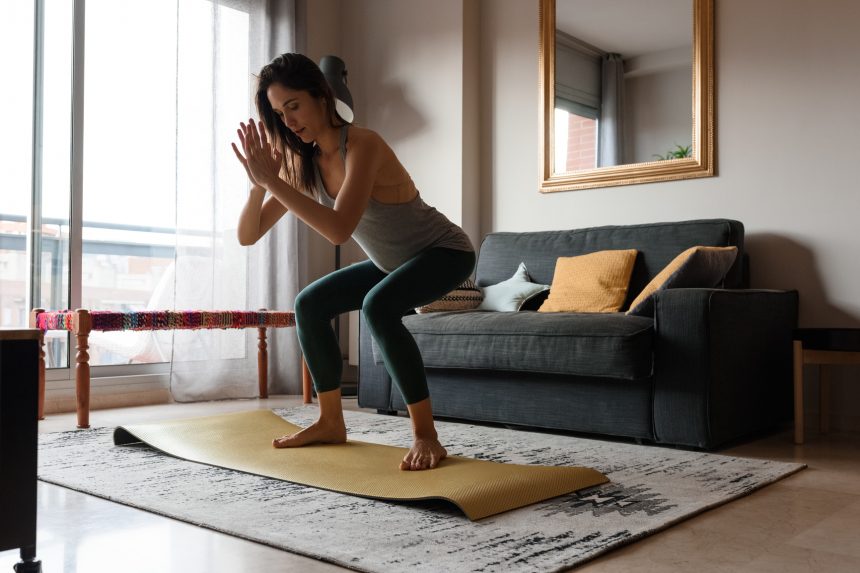For as long as we can remember, the advice has always been to skip the pre-sleep workout. Exercise in the morning, break a sweat during the day, or go for a run after work. But new research suggests that exercising before bed may not be as bad as previously thought.
“Although physical activity during the day can improve sleep, current sleep guidelines discourage exercise before bed due to the increase in heart rate and core body temperature,” says Jen Gale, a sedentary behavior researcher and co-author of a study published in BMJ Open Sport & Exercise Medicine.
Experts In This Article
- Jen Gale, Ph.D candidate at the University of Otago in New Zealand and sedentary behavior researcher
A small study found that incorporating 3-minute exercise breaks every half hour for 4 hours before sleep may actually improve the length and quality of sleep.
What’s the research saying?
In a review and analysis by Sports Medicine in October 2018, it was found that vigorous exercise ending within an hour of bedtime was associated with lower total sleep time and longer time to fall asleep. However, other types of exercises may have different effects.
Gale and her team selected 30 non-smokers between the ages of 18 to 40 who reported being sedentary for more than 5 hours during work and 2 hours in the evening. Participants wore activity trackers for 7 days to monitor their daily activities and sleep patterns.
Each participant completed two 4-hour sessions in a controlled environment on separate days. The first session involved sitting for 4 hours straight, whereas the second session included 3-minute bodyweight exercises every 30 minutes for 4 hours. After the sessions, participants returned to their normal routine.
The results showed that after incorporating activity breaks, participants slept an average of 27 minutes longer. While the study is small and further evidence is needed, it indicates that evening exercise may not be detrimental to sleep quality.
“If small bursts of activity in the evening can improve sleep, then frequent movement is likely beneficial for overall health,” Gale suggests.
What kind of exercise is good before bed?
High-intensity exercises like running, burpees, or jumping rope may not be ideal before bedtime. Instead, the study suggests short bouts of bodyweight resistance exercises may be beneficial.
The activity breaks in the study included three 20-second rounds of basic bodyweight moves such as chair squats, calf raises, and standing knee raises with straight leg hip extensions.
“Interrupting evening sitting time with regular activity breaks can improve sleep duration,” Gale explains. “The key is to break up prolonged sitting time in the evening before bedtime.”
Setting an alarm to move every 30 minutes or utilizing TV ad breaks as reminders to get up and stretch can help incorporate more activity into your evening routine.
3 exercises to try before bed
Here are three bodyweight exercises demonstrated by Robin Barrett, CPT, that are similar to those in the study. Perform each exercise for 15 to 20 seconds, repeating twice for a total of 3 rounds for potentially better sleep.
Calf Raise
Calf raises are recommended as they target often undertrained calf muscles that support the lower body.
- Stand tall with feet flat on the ground next to a wall.
- Hold onto the wall with one hand, lift the foot closest to the wall, and push through the ball of the other foot to elevate your heel.
- Lower your heel slowly and with control. Finish one side for 10 seconds before switching.
Squat
Squats offer numerous benefits beyond improved sleep, making them a great addition to any routine.
- Stand with feet shoulder-width apart and toes slightly outward.
- Keep your back straight and arms out or on hips as you bend knees and lower your body.
- Lower yourself as far as flexibility allows, keeping weight on heels.
- To stand, push through heels to return to starting position.
Lunge
The reverse lunge is easier on the knees than a forward lunge and can be gentler on the body before sleep.
- Stand with feet hip-width apart.
- Step back with one foot, lowering hips so thigh is parallel to the floor.
- Press into your heel to return to standing.
- Repeat on the opposite side.






